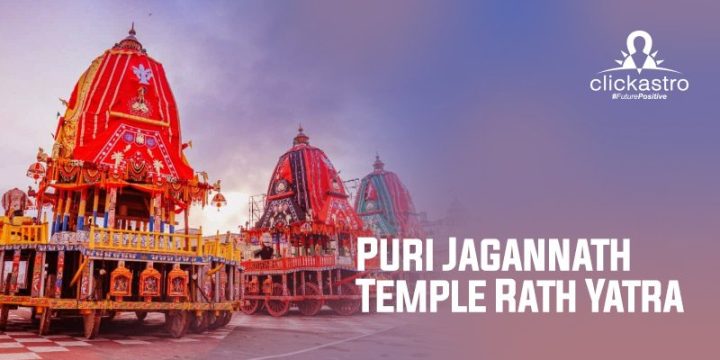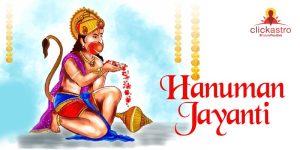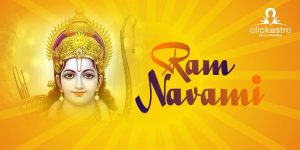Contents[hide]
Rath Yatra or Chariot Festival is an annual Hindu festival associated with Lord Jagannath (Sri Krishna). It is annually held in the states of Odisha, Bihar, Jharkhand, West Bengal, Gujarat etc. The biggest and the most significant of these Rath Yatra festivals is the one at Puri Jagannath temple in the eastern state of Odisha; the next is the Ahmedabad Rath Yatra in the western state of Gujarat. Puri Jagannath Rath Yatra (chariot procession) is celebrated on the Shukla Paksha Dwitiya (second lunar day in the bright fortnight) of the Ashadha month, June, or July in the Gregorian calendar. This is the oldest and the most famous Rath Yatra, whose descriptions can be found in ancient scriptures viz. Brahma Purana, Padma Purana, Skanda Purana, and Kapila Samhita. This festival marks the annual ceremonial procession of Lord Jagannath (Lord Krishna), his elder brother Balabhadra (Lord Balram), and younger sister Subhadra from their home temple to another temple located in what is believed to be their aunt’s home. The Puri Jagannath Rath Yatra, in which the three deities are taken out of their temples in a colorful procession, is unique for its great religious and historical significance.Puri Jagannath Rath Yatra 2023 will be held on Tuesday, June 20.
Puri Jagannath Temple
One should know the significance of Puri Jagannath Temple to understand the specialty of Rath Yatra held here. The magnificent Jagannath Temple is located on the Eastern coast in Puri, approximately 60 km away from Bhubaneswar, the capital of Odisha. It is one of the most important pilgrimage destinations for the Hindus. This sacred shrine in Puri is one of the Char Dham pilgrimage sites, which the Hindus are supposed to visit once in their lifetime. The other sites are Badrinath, Rameswaram, and Dwaraka. Sri Jagannath Temple of Puri is dedicated to Lord Jagannath, a form of Vishnu. Lord Jagannath, his elder brother Balabhadra, and his sister Subhadra are the three main deities worshipped here. The temple also houses the deities of Sudarshan, Madhaba, Sridevi, and Bhudevi. Unlike the stone and metal idols in most Hindu temples, here, the idol of Jagannath is made of wood. The inner sanctum of the temple contains the idols of the three deities carved from sacred neem logs known as Daru, sitting on a bejeweled platform or Ratnabedi. The deities, who are malformed with large heads and no arms, are adorned with different clothing and jewels in different seasons. Every twelve or nineteen years, these idols are ceremoniously replaced by a replica. It was in 2015; these deities were last replaced. The worship of these deities is believed to pre-date the building of the temple and originated in an ancient tribal shrine. The present temple was rebuilt on the site of an earlier temple in the 12th century AD by King Anantavarman Chodaganga Deva of the Eastern Ganga dynasty. Puri, along with Konark and Bhubaneshwar, form the Golden Triangle of Orissa.Significance of Puri Jagannath Temple
Puri Jagannath Temple is one of the four holiest Char Dham pilgrimage sites. Many great Vaishnava saints, such as Ramanujacharya, Madhvacharya, Nimbarkacharya, Vallabhacharya, and Ramananda were associated with this temple. Ramanujacharya established the Emar Mutt near the temple. Srimad Vallabhacharya has visited this place and performed a 7-day recitation of Srimad Bhagvat. His sitting place is still famous as Baithakji. Sri Chaitanya Mahaprabhu, the founder of Gaudiya Vaishnavism, was attracted to the deity Jagannath and stayed in Puri for many years. The temple is also associated with Sri Adi Sankaracharya, who established his Govardhana mutt here. This temple also gives evidence for the visits of Guru Nanak, Kabirdas, and Tulsidas. Besides these, the Jagannath Temple of Puri displays some astonishing facts which add to its mystical significance. One may find it impossible to give a scientific explanation for these astonishing facts. Some of these facts are the following.- The flag mounted on top of the main pagoda of the temple flows in the opposite direction to the wind’s course without any scientific background to back it up.
- The temple casts no shadow at any time of the day and from any direction possible.
- No birds can be seen resting or flying above the temple dome.
- The temple spot is near the ocean. Yet, the audibility of the sea will be completely lost once you enter the temple premises.
- The priests of the temple use seven pots for cooking the prasadam. They are mounted one over the other and heated using firewood. Miraculously, the topmost pot is cooked first, and the rest follows the same order.
Puri Jagannath Rath Yatra 2023
Puri Jagannath Rath Yatra 2023 will be held on Tuesday, June 20. Significant Auspicious timings on Puri Rath Yatra- Sunrise: June 20, 2023, 5:45 AM
- Sunset: June 20, 2023, 7:10 PM
- Dwitiya Tithi Begins: June 19, 2023, 11:25 AM
- Dwitiya Tithi Ends: June 20, 2023, 1:07 PM
What is Puri Jagannath Rath Yatra?
The Rath Yatra festival of Sri Jagannath Temple in Puri starts from the Dwitiya (second lunar day) of Shukla Paksha (waxing phase) of the month of Ashadha (3rd month in the Odia calendar). The presiding deities of the Jagannath Temple, Lord Jagannath, his brother Lord Balabhadra, and sister Subhadra, along with the celestial wheel Sudarshana Chakra are removed from the temple in a ceremonial procession to their chariots. The chariots would be lined across the wide avenue in front of the temple close to its Sinhadwara or eastern entrance. The huge, colorfully decorated chariots are then drawn by the mass of devotees on the Bada Danda to the Gundicha (King Indradyumna’s Queen) Temple two miles away to the North. On the way, the chariot of Lord Jagannath (Nandighosa) halts near the crematorium of Bhakta Salabega, a Muslim devotee, to pay tribute to him. During their return from the Gundicha Temple, the three chariots carrying the deities stop at Mausi Maa Temple (Aunt’s abode) and have an offering of the Poda Pitha (a special type of pancake supposed to be the Lord’s favorite). After a seven-day stay, the deities come back to their abode, the Jagannath Temple. The significance of the Rath Yatra is immense for those who long for spiritual merit. It is believed that anyone who pulls the rope of the chariots or helps others in doing so gets the merit of several penances. Every year, millions of people come to watch the Rath Yatra in which three massive 18-wheeled chariots, which are mini architectural marvels, make their way through the crowd. It is the size, pomp, and splendor of the Jagannath Rath Yatra that contributed the word ‘Juggernaut’ to the English dictionary. This festival also showcases several interesting customs, which include the king sweeping the road with a golden mop.The Puri Jagannath Rath Yatra Chariots
Every year, the chariots of Jagannath, Balabhadra, and Subhadra are rebuilt. The three chariots are constructed in over 42 days from over 4,000 pieces of wood (of specified trees like Phassi, Dhausa, etc.) by a family of carpenters who has hereditary rights for the same. The woods are customarily brought from the ex-princely state of Dasapalla by this special team of carpenters. Following the tradition, the logs are set afloat as rafts in the river Mahanadi which are then collected near Puri and transported by road. Every year, the construction of the chariots begins on Akshaya Tritiya (the third lunar day of the bright fortnight of the month Vaisakha) with ritual fire worship in front of the palace of the King of Puri. This day also marks the beginning of the summer festival of the deities known as the Chandan Yatra (sandalwood festival), which lasts for three weeks. This festival which includes various interesting rituals culminates with the Snana Yatra, the bathing festival on the full moon day of Jyeshta month. The three chariots are constructed and decorated following a unique scheme prescribed and followed for centuries. Each of these will have a guardian, a charioteer, a flag, four horses, two gatekeepers, and nine subsidiary deities.Chariot of Jagannath
- Name: Nandighosha
- Alternate names: Garudadhwaja, Kapiladhwaja
- Total Number of wooden pieces used: 832
- Number of wheels: 16
- Dimensions (Height x Length x Breadth): 44′ 2″ x 34’6″ x 34’6″
- Colors of the canopies: Red and Yellow
- Guardian: Garuda
- Charioteer: Daruka
- Flag name: Trailokyamohini
- Name of Horses: Shankha, Balahaka, Suweta, Haridashwa
- Name of Chariot Rope: Sankhachuda Nagini
- Accompanying deity: Madanmohan
- Gatekeepers (Dvarapala): Jaya, Vijaya
- Nine Parshvadevata (Subsidiary deities): Panchamukhi Mahabir, Harihara, Madhusudana, Giridhar, Pandu Narasingha, Chitamani Krishna, Narayana, Chatra Bhanga Rabana, Rama seated on Hanuman
Chariot of Balabhadra
- Name: Taladhwaja
- Alternate name: Langaladhwaja
- Total Number of wooden pieces used: 763
- Number of wheels: 14
- Dimensions (Height x Length x Breadth): 43′ 3″ x 33′ x 33′
- Colors of the canopies: Red and Bluish green
- Guardian: Vasudev
- Charioteer: Matali
- Flag name: Unnani
- Name of Horses: Tribra, Ghora, Dirghasharma, Swornanava
- Name of Chariot Rope: Basuki Naga
- Accompanying deity: Ramakrishna
- Gatekeepers (Dvarapala): Nanda, Sunanda
- Nine Parshvadevata (Subsidiary deities): Ganesha, Kartikeya, Sarvamangala, Pralambari, Halayudha, Mrityunjaya, Natamvara, Mukteswar, Sheshadeva
Chariot of Subhadra
- Name: Darpadalana
- Alternate names: Devadalana, Padmadhwaja
- Total Number of wooden pieces used: 593
- Number of wheels: 12
- Dimensions (Height x Length x Breadth) :
42’3″ x 31’6″ x 31’6″ - Colors of the canopies: Red and Black
- Guardian: Jayadurga
- Charioteer: Arjuna
- Flag name: Nadambika
- Name of Horses: Rochika, Mochika, Jita, Aparajita
- Name of Chariot Rope: Swarnachuda Nagini
- Accompanying deity: Sudarshana
- Gatekeepers (Dvarapala): Ganga, Jamuna
- Nine Parshvadevata (Subsidiary deities): Chandi, Chamunda, Ugratara, Banadurga, Shulidurga, Varahi, Shyamakali, Mangala, Vimala







